

2. What's new in Spring Security 3.1. Spring Core. Le coeur de Spring est composé de Spring Core : il est composé d'un conteneur qui implémente le motif de conception IoC (Inversion of Control).
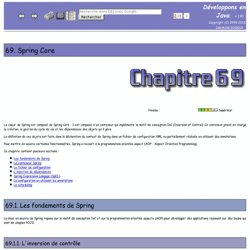
Ce conteneur prend en charge la création, la gestion du cycle de vie et les dépendances des objets qu'il gère. La définition de ces objets est faite dans la déclaration du context de Spring dans un fichier de configuration XML ou partiellement réalisée en utilisant des annotations. Documentation. Spring Framework. Introduction.

Overview (Spring Framework 3.2.1.RELEASE API) Spring Framework - Reference Documentation. 4. The IoC container. 4.1 Introduction to the Spring IoC container and beans This chapter covers the Spring Framework implementation of the Inversion of Control (IoC) []principle.
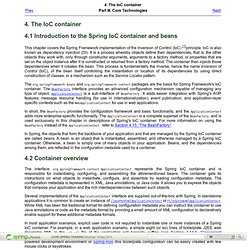
IoC is also known as dependency injection (DI). It is a process whereby objects define their dependencies, that is, the other objects they work with, only through constructor arguments, arguments to a factory method, or properties that are set on the object instance after it is constructed or returned from a factory method. The container then injects those dependencies when it creates the bean. This process is fundamentally the inverse, hence the name Inversion of Control (IoC), of the bean itself controlling the instantiation or location of its dependencies by using direct construction of classes, or a mechanism such as the Service Locator pattern.
IoC - Standard and Custom Events. 4.1 Introduction to the Spring IoC container and beans This chapter covers the Spring Framework implementation of the Inversion of Control (IoC) []principle.
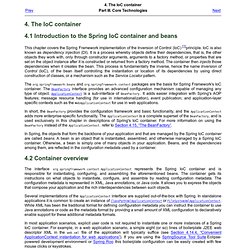
IoC is also known as dependency injection (DI). It is a process whereby objects define their dependencies, that is, the other objects they work with, only through constructor arguments, arguments to a factory method, or properties that are set on the object instance after it is constructed or returned from a factory method. The container then injects those dependencies when it creates the bean. This process is fundamentally the inverse, hence the name Inversion of Control (IoC), of the bean itself controlling the instantiation or location of its dependencies by using direct construction of classes, or a mechanism such as the Service Locator pattern.
Scope singleton. 4.1 Introduction to the Spring IoC container and beans This chapter covers the Spring Framework implementation of the Inversion of Control (IoC) []principle.
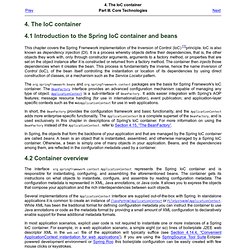
IoC is also known as dependency injection (DI). It is a process whereby objects define their dependencies, that is, the other objects they work with, only through constructor arguments, arguments to a factory method, or properties that are set on the object instance after it is constructed or returned from a factory method. The container then injects those dependencies when it creates the bean. This process is fundamentally the inverse, hence the name Inversion of Control (IoC), of the bean itself controlling the instantiation or location of its dependencies by using direct construction of classes, or a mechanism such as the Service Locator pattern. Part V. The Web. This part of the reference documentation covers the Spring Framework's support for the presentation tier (and specifically web-based presentation tiers).

The Spring Framework's own web framework, Spring Web MVC, is covered in the first couple of chapters. A number of the remaining chapters in this part of the reference documentation are concerned with the Spring Framework's integration with other web technologies, such as Struts and JSF (to name but two).
20. Remoting and web services using Spring. 7. View technologies. Spring provides a couple of out-of-the-box solutions for JSP and JSTL views.

Using JSP or JSTL is done using a normal view resolver defined in the WebApplicationContext. Furthermore, of course you need to write some JSPs that will actually render the view. JasperReports Library. JasperReports - Features and Highlights. Overview Layout and Interactive Features Pixel-perfect page-oriented or continuous output for web or printDashboards, tables, crosstabs, charts, gauges, and widgetsSubreports easily handle highly complex layoutsIntegrated barcode supportVisual text rotationStyles libraryDrill-through / hypertext links, including support for PDF bookmarksInteractive table elements and subreports for interactive and complex layoutsConditional printing Flexible Deployment and Output Report output in PDF, XML, HTML, CSV, XLS, RTF, TXTInternationalized and localizable for global deployments Any Data Source Connectivity JasperReports uses any data source provider, allowing it to extend reporting capabilities to almost any third-party application.
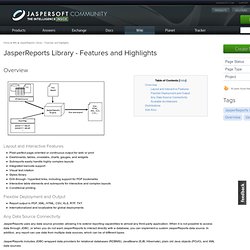
JasperReports 5.0.1 - Configuration Reference. JasperReports 5.0.1 - Configuration Reference - export CSV. JasperReports - Reference Materials. JasperReports - Tutorial. In order to fill a report-design, one can use the fillReportXXX() methods exposed by the JasperFillManager class.
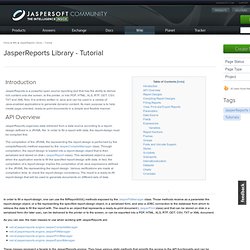
Those methods receive as a parameter the report-design object, or a file representing the specified report-design object, in a serialized form, and also a JDBC connection to the database from which to retrieve the data to fill the report with. The result is an object that represents a ready-to-print document ( JasperPrint class) and that can be stored on disk in a serialized form (for later use), can be delivered to the printer or to the screen, or can be exported into a PDF, HTML, XLS, RTF, ODT, CSV, TXT or XML document. As you can see, the main classes to use when working with JasperReports are: These classes represent a facade to the JasperReports engine. If you need to display the report inside a Swing application, you can use the JRViewer component that is shipped with the library and consists of an embeddable and configurable javax.swing.JPanel component.
JacksonExtensionCSV - FasterXML Wiki. This extension package adds support for using Jackson for reading and writing CSV (spec) encoded data.

Support is implemented by implementing low-level support (JsonFactory, JsonParser and JsonGenerator sub-classes) to expose CSV as sequence of JsonToken events. One additional constraint is that CSV-encoded data needs to have a schema that defines logical names for columns. This can either be explicitly passed, or required to found from the first line of input. Project. FasterXML/jackson-dataformat-csv. RFC 4180 - Common Format and MIME Type for Comma-Separated Values (CSV) Files.
[Docs] [txt|pdf] [draft-shafranovic...] [Diff1] [Diff2] Updated by: 7111 INFORMATIONAL Network Working Group Y. Shafranovich Request for Comments: 4180 SolidMatrix Technologies, Inc. Category: Informational October 2005 Status of This Memo This memo provides information for the Internet community. It does not specify an Internet standard of any kind. RFC 4180 Common Format and MIME Type for CSV Files October 2005 1.
Apache POI - the Java API for Microsoft Documents. Jxls - Welcome to jXLS. Excel and Java - Read and Write Excel with Java. Excel and Java - Read and Write Excel with Java - Tutorial Copyright © 2008, 2009, 2010, 2011, 2012 Lars Vogel Abstract This article demonstrate how to create and how to read Excel files with the Java Excel API. 2. Create an Excel Spreadsheet Create a new Java project called de.vogella.java.excel. I assume that the code is pretty much self-explaining. 3. Spring Security. Spring Security - JTips. Un article de JTips. Le module Acegi a été rebaptisé en version 2 par Spring Security.
Outre ce renommage, cette nouvelle version apporte des schémas XML qui simplifient considérablement la configuration. Spring Security permet de gérer l'accès aux ressources d'une application Java. Ces ressources peuvent être des pages web, mais aussi des objets de services métier. Toute ressource sollicitée par un appelant est rendue accessible si, d'une part, l'appelant s'est identifié, et si d'autre part, il possède les droits nécessaires (des rôles dans le vocabulaire Spring Security). Dans cet article, nous traiterons le cas de la sécurisation des pages web. Spring Integration. Introduction Using the Spring Framework encourages developers to code using interfaces and use dependency injection (DI) to provide a Plain Old Java Object (POJO) with the dependencies it needs to perform its tasks.
Spring Integration takes this concept one step further, where POJOs are wired together using a messaging paradigm and individual components may not be aware of other components in the application. Such an application is built by assembling fine-grained reusable components to form a higher level of functionality. WIth careful design, these flows can be modularized and also reused at an even higher level. In addition to wiring together fine-grained components, Spring Integration provides a wide selection of channel adapters and gateways to communicate with external systems. Spring Integration Reference Manual. Spring Integration provides Channel Adapters for receiving and sending messages using the Advanced Message Queuing Protocol (AMQP). The following adapters are available: Home - Enterprise Integration Patterns.